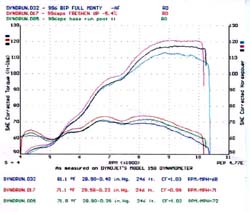|
All this has got us thinking, the 996SPS is very similar to the 996Bip. Sure there are changes but it is important to divide the parts on the SPS put on the
bike to make it the premium model in the range and parts that make a difference to power and reliability for real world use. The carbon fibre is very good, it fits and works brilliantly, much better than a lot
of the carbon fibre we have seen, but the standard plastic works just as well (Yes Fred, even the air inlet ducts….). suspension wise there is the rear shock, Ohlins please. (and in the year2000 bikes also
Ohlins front Forks; Probably £2000 to retro fit the whole lot…). For the engine though there are two distinct groups of components that are different, those for engine strength and those for the power.
The SPS' role as a homologation special for racing shows in the crankcase halves without a separate centre gasket, the P8 'big brain' computer and wiring loom and finally the exotic Pankl Titanium rods. Power comes from revised cams, 50mm bore exhaust and a half point of compression.
We have been buried in the PC and burning the midnight oil. There are a lot of the power producing parts of the 996SPS that an be duplicated at reasonable
cost, all of it can obviously be duplicated if there is a more generous budget. We can fit the Cams, we can fit the exhaust system and, thanks to a gifted computer engineer at Eprom that duplicates the SPS fuel maps
in a version that works in the 'Little Brain' 1.6 computer. Our Full Monty rebuild gives you the benefit of as much of the compression as can be raised from the standard piston and head arrangement. The SPS motor uses different cylinder heads with a higher resulting compression ratio, we can obviously refit these but that is a slightly higher cost and by the time you add it all up a Foggy rep starts to look a good deal. We believe the compression is worth about 3 hp at the top end, but the lower compression greatly takes the pressure 9sic10 off the conrods making the standard parts a perfectly acceptable solution.
Caution: It is important that anyone thinking of going this route is very honest with
themselves as to their intended use, the stiffer crankcase arrangement and the Ti rods are there to let a 996cc engine live at a constant and abusive 11000 rpm plus; the sort of abuse that comes with changing at the
redline for hours on end and banging down three gears at once going into corners.
If you're mainly a road user or do a couple of track days a year there is no problem, the standard rods will be more than good enough. The Eprom we have has a revlimiter at 10500rpm, this is there to keep things in one piece, in the end it's your choice.
 There are several variations possible; we can replace the cams and build in the highest compression we can get to with the standard head
and pistons. At the very least this will allow the engine to hold onto its power for much longer, and add several bhp, combined with the gearing changes we recommend there will be a substantial
boost at the top end, there are probably another couple of HP with a big bore exhaust, this would have other effects as the greater back pressure from the smaller pipe would give a little more
power low down, but is a bit stifling at the top. See 'Supermono Tech; Donington and onwards' for the basic principles. You can see the sort of effect that will be achieved in our final dyno chart; this is a direct comparison with Marks 996Bip (Dynorun032
) and the before (Dynorun005) and after (Dynorun017) refresher curves of the 996SPS. There are several variations possible; we can replace the cams and build in the highest compression we can get to with the standard head
and pistons. At the very least this will allow the engine to hold onto its power for much longer, and add several bhp, combined with the gearing changes we recommend there will be a substantial
boost at the top end, there are probably another couple of HP with a big bore exhaust, this would have other effects as the greater back pressure from the smaller pipe would give a little more
power low down, but is a bit stifling at the top. See 'Supermono Tech; Donington and onwards' for the basic principles. You can see the sort of effect that will be achieved in our final dyno chart; this is a direct comparison with Marks 996Bip (Dynorun032
) and the before (Dynorun005) and after (Dynorun017) refresher curves of the 996SPS.
By the time we have got the fueling right I am sure such a motor; cams, exhaust, Full Monty and
Eprom will have as good a level of power as a standard 996SPS. Of course if you really want to go for it we can fit the heads and rods from the SPS as well, we would probably have to have a bit
of a chat about the costs of that………
Neil Spalding
|